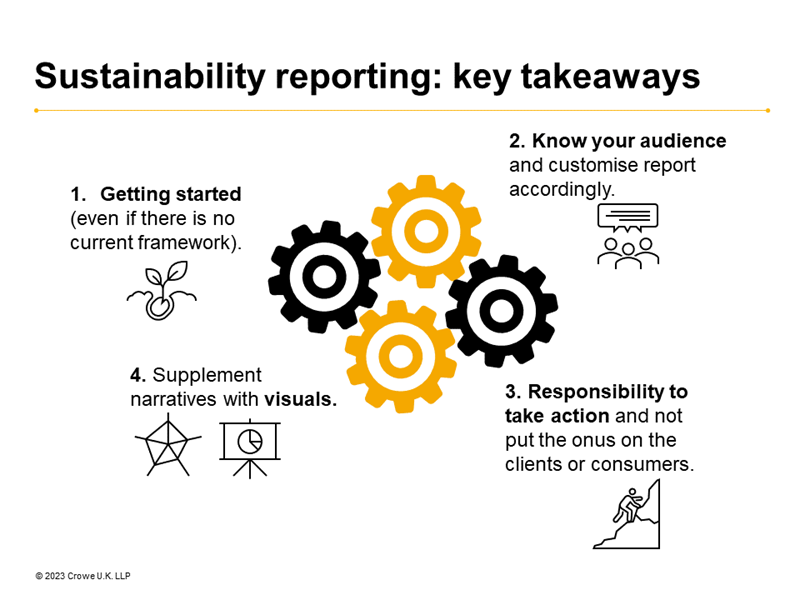
Key takeaways from Coldplay’s first sustainability report

Firms are progressively thinking about how they can reduce their emissions and become more sustainable, as part of their overall approach to ESG. Financial service organisations, pushed by a wide range of regulations, are typically leading the way in sustainability reporting, but they are not alone; some big names that have sought to understand and measure their impact in order to reduce it, include clothing brand Patagonia and craft brewery New Belgium Brewing.
In this article, we look at Coldplay’s first sustainability report and have identified key learnings for other companies who are getting started on their sustainability journey. We explore how the band has addressed the challenges of measuring a fairly unique business, including tailoring their report to their audience.
Despite having no requirements or set standards to follow for their sustainability disclosures, Coldplay’s report is similar in structure to a Taskforce Climate-related Financial Disclosures (TCFD) report. It seems that the band approached this reporting with the risk management cycle in mind and considered different aspects that are likely to affect them and their stakeholders, such as their fans and suppliers, and have then set up realistic and innovative mitigating or adaptation actions to address those sustainability issues, such as:
- Installing kinetic floors and electricity-generating power bikes - these kinetic floors convert the fans’ dancing, i.e., kinetic energy into electricity, which is then used to power the show. Furthermore, they also have electricity-generating power bikes in place that the fans could use to charge the show batteries. Such ‘user generated’ electricity options are becoming more popular, with boutique gyms experimenting with generating electricity from spin bikes, and bikes with dynamo attachments, a common method for charging mobile phones in disaster zones.
- Using Sustainable Aviation Fuel (SAF) for their flights and electric vehicles or biofuel for other transport - SAF is a waste-derived fuel which reduces the GHG emissions of air travel by up to 80%. International Air Transport Association (IATA) estimates that SAF could help in reducing emissions by 65% for the aviation sector to reach net zero in 2050. The use of SAF also forms part of the “Jet Zero” strategy which commits UK domestic aviation to reach net zero by 2040. Coldplay not only use SAF for their commercial and charter flights, but also supply SAF for others’ use. Moreover, they use electric vehicles or biofuel-powered vehicles for ground transport.
- Incentivising fans to use low carbon transport - Coldplay partnered with SAP, a German software company, on the development of the “Coldplay Music of the Spheres World Tour app”. The app can be downloaded for free and shows the impact of the different modes of transport. If the fan’s journey is rated as green, then they get a discount on merchandise, thus incentivising them to choose low-carbon modes of transport to and from shows. The app is also an educational platform for fans to learn more about the tour’s environmental initiatives.
The three principles that underpin their strategy to being as sustainable and low-carbon as possible are:
- Reduce: reduce their carbon emissions, consumption and recycle as much as possible
- Reinvent: use green technology and sustainable, low-carbon touring methods
- Restore: invest in green initiatives which is carbon offsetting.
While these principles mostly focus on the climate side of the environmental social governance (ESG) issues, they mirror typical strategies adopted by some of the financial institutions in the TCFD benchmarking exercise: namely decarbonisation, green investment and stakeholder engagement. Furthermore, while Coldplay did not have any guide per se for sustainability reporting, a glance at their report shows that the key headings can be loosely mapped to the draft European Sustainability Reporting Standards (ESRS), relating to the environmental and social aspects, showing that there was a well-thought process behind their sustainability reporting that has allowed them to map the ESRS to their own unique sustainability challenges.

Figure 1: Mapping the different themes of Coldplay’s sustainability report to ESRS
Unlike insurer sustainability reports, Coldplay’s report is designed with the public in mind. An important lesson here, is to consider your audience and the purpose of your report. Sustainability reports in financial services are usually designed for highly sophisticated stakeholders, rather than the public but can still benefit from some of the simple explanations we see from Coldplay. In particular, the use of brilliant and interactive visuals creates a powerful message, and they are very clear on where they are at the moment, in terms of their sustainability journey, and on the actions they are taking to reach their targets. Many corporate sustainability reports fail to show that sustainability is embedded at the heart of the business and as a result, the reports tend to be dense, and overly complex due to the overuse of figures and often lack clarity when addressing ESG issues. Here we see that the adage “A picture represents a thousand words” holds true.
Conclusion
Coldplay’s approach to sustainability will not be applicable to most financial services firms. However, there are some valuable lessons that all firms can adopt.
|
Key takeaways from Coldplay’s sustainability report include:
|
Please contact Lloyd Richards or Alex Hindson for more information.

Insights
Contact us



